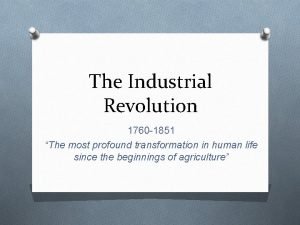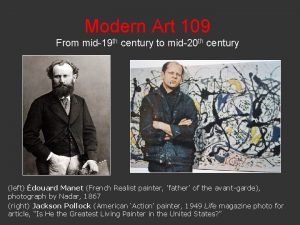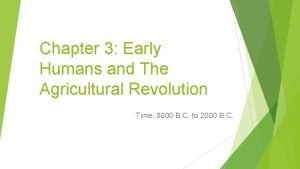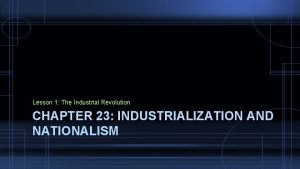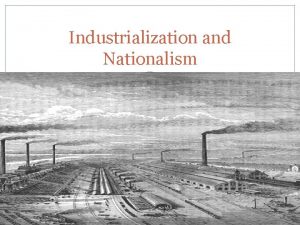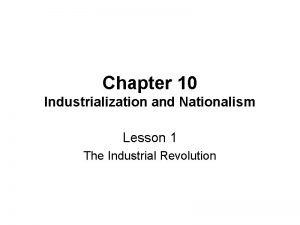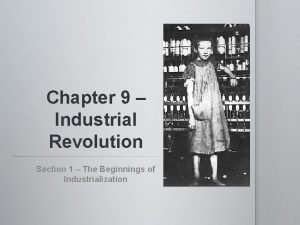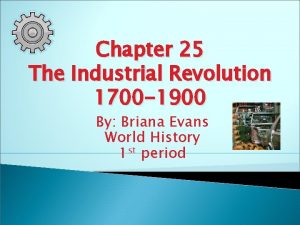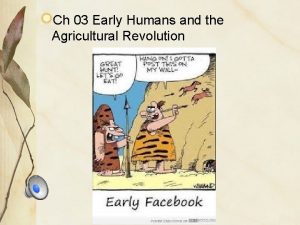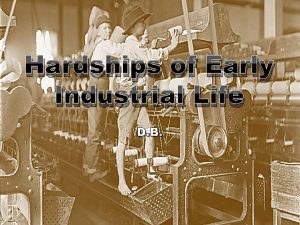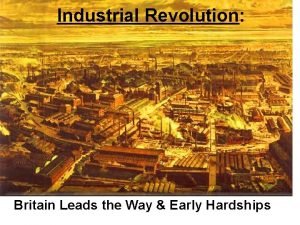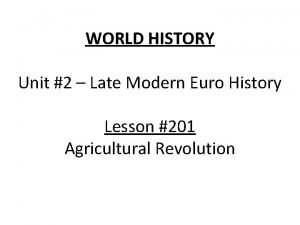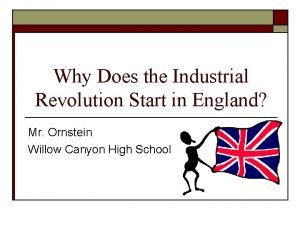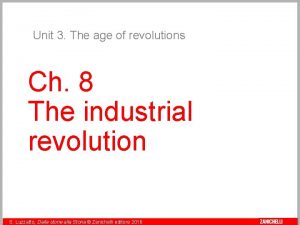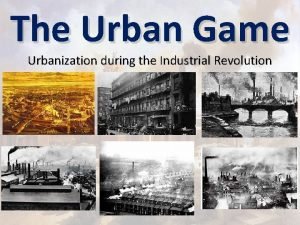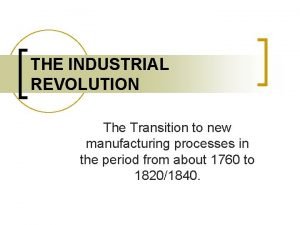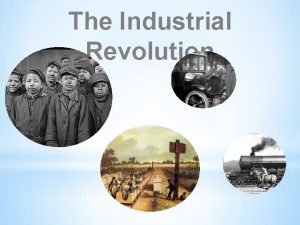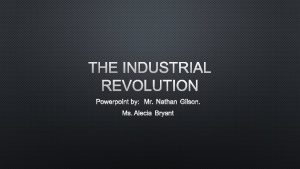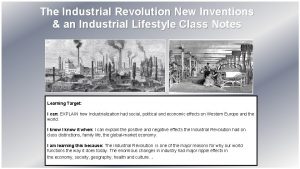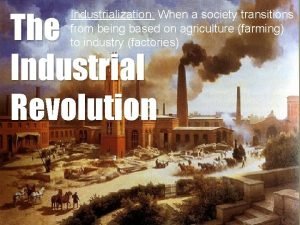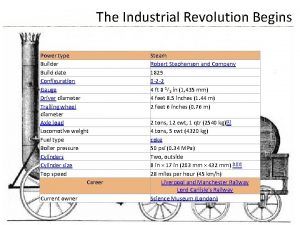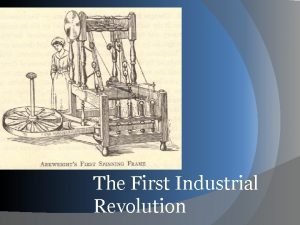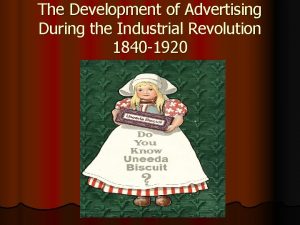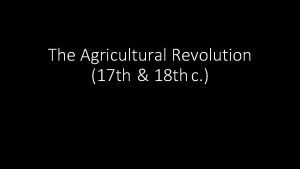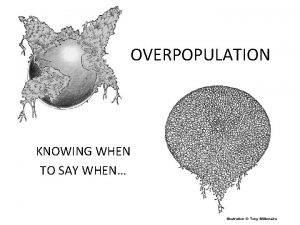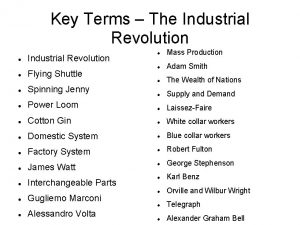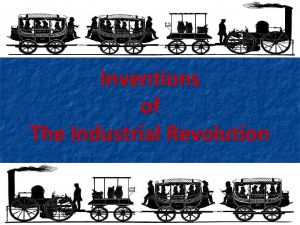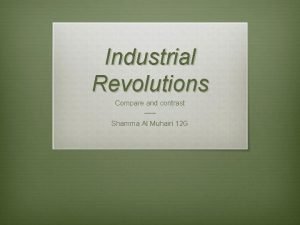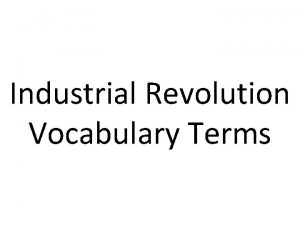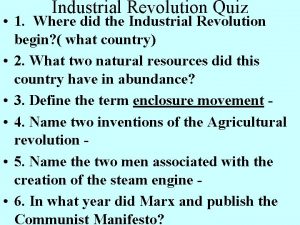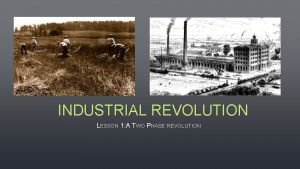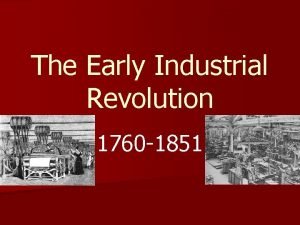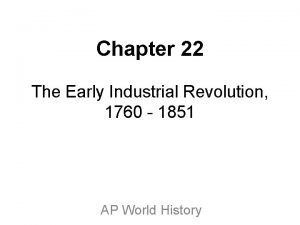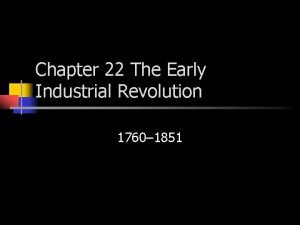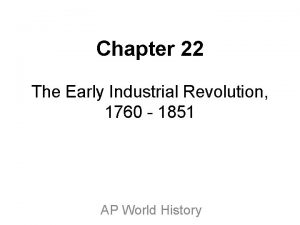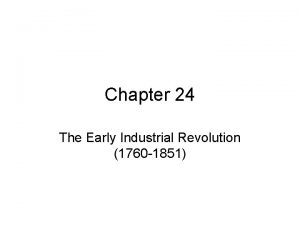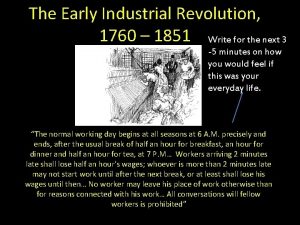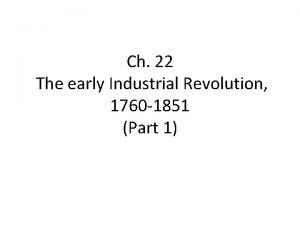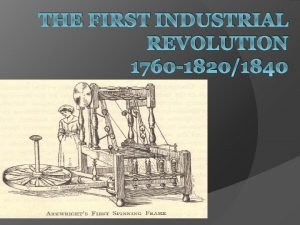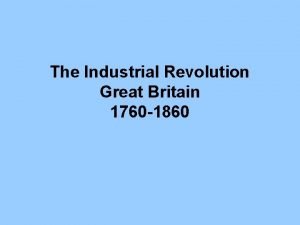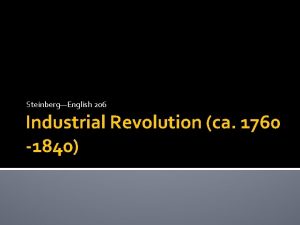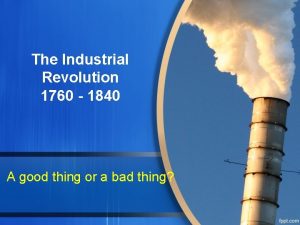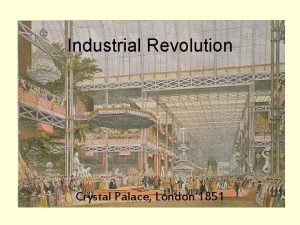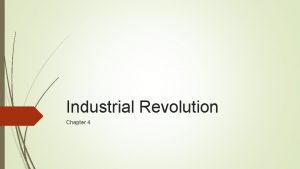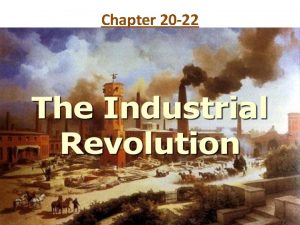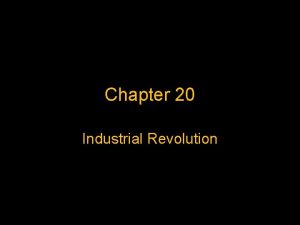Chapter 22 The Early Industrial Revolution 1760 1851







































- Slides: 39

Chapter 22 The Early Industrial Revolution 1760– 1851

CAUSES OF THE INDUSTRIAL REVOLUTION n n Population Growth In the eighteenth century more reliable food supplies, earlier marriage, high birthrates, and more widespread resistance to disease contributed to significant population growth in Europe. England Wales experienced particularly rapid population growth

n n Rapid population growth meant that children accounted for a relatively high proportion of the total population. Population growth also contributed to migration of people from the countryside to the cities, from Ireland to England, and from Europe to the Americas

The Agricultural Revolution n n The agricultural revolution began long before the eighteenth century. New food crops, many of them from the Americas, such as potatoes from South America and corn from North America produced more food per acre and allowed farmers to raise more cattle for meat and milk

n A Watt steam engine, the steam engine fuelled primarily by coal that propelled the Industrial Revolution in Britain and the world. It would be used for metal machine tools in the textile industry and other industries. [1]

The Technological Revolution Mass Production: Pottery n n Pottery was either imported or handmade for the aristocracy; in either event, ordinary people could not afford it. But the growing taste for tea, cocoa, and coffee created a demand for porcelain that would not spoil the flavor of these beverages

Mechanization: the Cotton Industry n n There was a strong market for cotton cloth, but the cotton plant did not grow in Europe. Restrictions on the import of cotton cloth led inventors and entrepreneurs to devise cheap mechanical methods for spinning cotton thread and weaving cotton cloth in England.

n n n Beginning in the 1760 s a series of inventions revolutionized the spinning of cotton thread. These included the spinning jenny (1764), the water frame (1769), and the mule (1785). The increased supply of cotton thread and the demand for cotton cloth led to the invention of power looms and other machinery and processes for cotton textile production

“Spinning Jenny” Used Manpower to create High quality yarn for textile industry “Spinning Mule” Used water power to produce high quality yarn for textiles

Power Looms used to make great amounts of fabric very quickly

n n Mechanization of cotton textile production led to much greater efficiency and lower prices. Cotton became America’s most valuable crop, produced for export to England and, from the 1820 s, for America’s own cotton textile industry

The Iron Industry n n n Iron had been in use in Eurasia and Africa for thousands of years However iron production was associated with deforestation that increased the price of charcoal and thus reduced the output of iron. Limited wood supplies and the high cost of skilled labor made iron a rare and valuable metal outside of China before the eighteenth century

n The Iron Bridge ca. 1778 n In the eighteenth century a series of inventions including coke (byproduct of coal used to help make iron) and puddling (method used to make a stronger type of steel) made it possible for the British to produce large amounts of cheap high quality iron. Increased production and lower cost led people to use iron for numerous applications including bridge building and the construction of the Crystal Palace

n n The idea of interchangeable parts originated in the eighteenth century, but it was widely adopted in the firearms, farm equipment, and sewing machine industries in the nineteenth century. The use of machinery to mass-produce consumer goods with identical parts was known as “the American system of manufactures

The Steam Engine n n The steam engine was the most revolutionary invention of the Industrial Revolution. Between 1702 and 1712 Thomas Newcomen developed an inefficient steam engine that was used to pump water out of coal mines

n n In 1769 James Watt improved the Newcomen engine and began to manufacture engines for sale to manufacturers. Watt’s engine provided a source of power that allowed factories to be located where animal, wind, and water power were lacking

Model of steamship, built in 1784 n n In the 1780 s the steam engine was used to power riverboats in France and America. In the 1830 s the development of more efficient engines made it possible to build ocean-going steamships

Railroads Trevithick's 1804 locomotive n After 1800 inventors including Richard Trevithick and George Stephenson built lighter, more powerful highpressure steam engines and used them to power steam locomotives that soon replaced the horses on horsepower railways

n n Railway-building mania swept Britain from 1825 to 1845 as the major cities, and then small towns, were linked by a network of railroads. In the United States, railway booms in the 1840 s and 1850 s linked the country together and opened the Midwest to agricultural development

n n In Europe, railways triggered industrialization. Europe’s industrial areas were concentrated in the iron and coal-rich areas of northern France, Belgium, the Ruhr, and Silesia

Criticism of the new Bourgeoisie

Stereotype of the Factory Owner

Problems with Pollution

Communication Over Wires n n The construction of railroads was accompanied by the development of the electric telegraph. (Samuel F. B. Morse Two systems of telegraphy were invented in 1837: Wheatestone and Cook’s five-needle telegraph in England, and Morse’s dots and dashes system in the United States

The Impact of the Industrial Revolution

n n Sudden population growth, crowding, and lack of municipal services made urban problems more serious than they had been in the past. Inadequate facilities for sewage disposal, air and water pollution, and diseases made urban life unhealthy and contributed to high infant mortality and short life expectancy

n n New transportation systems greatly changed rural life. Toll roads, canals, and then railroads linked isolated districts to the great centers of commerce, industry, and population

Working Conditions n n Industrialization offered new, highlypaid opportunities for a small number of skilled carpenters, metalworkers, and machinists; but most industrial jobs were unskilled, repetitive, boring, badly paid, and came with poor working conditions The separation of work from home had a major impact on women and on family life

n n n Women workers were concentrated in the textile mills and earned much less than men. Husbands and wives worked in separate places. Most of the female work force consisted of young women who took low-paid jobs as domestic servants

n n Poverty and employers’ preference for child workers led to high rates of child labor. In the mid-nineteenth century the British government restricted child labor, so mill owners recruited Irish immigrants instead Child pulling coal out of mine

n n The Industrial Revolution increased the demand for cotton, sugar, and coffee. In doing so, industrialization helped to prolong slavery in the United States and the Caribbean and to extend slavery to the coffee-growing regions of Brazil

n n The real beneficiaries of the Industrial Revolution were the middle classes. Rising incomes allowed the middle class to build their own businesses, to keep their women at home, and to develop a moral code that stood in contrast to the squalor and drunkenness of the working class

New Economic and Political Ideas

Laissez Faire and Its Critics n n n Adam Smith was the most famous proponent of the laissez-faire doctrine that government should refrain from interfering in business. Thomas Malthus and David Ricardo argued that the poverty of the working class was the result of over -population and that it could best be addressed, not by government action, but by delayed marriage and sexual restraint. Business people welcomed the idea of laissez faire.

n Critics of laissez faire, such as Jeremy Bentham in England Freidrich List in Germany, argued that the state should take action to manage the economy and to address social problems.

Positivists and Utopian Socialists n In France, the count of Saint-Simon developed a philosophy called positivism, which argued that the scientific method could solve social as well as technical problems.

n n The utopian socialists include Charles Fourier, who imagined an ideal society without capitalists, and Robert Owen, who believed that industry could provide prosperity for all. Owen tried to put his ideas into practice by carrying out reforms in his own textile mill and by encouraging Parliament to pass child labor laws and establish government inspection of working conditions.

Protests and Reforms n n Workers initially responded to the harsh working conditions by changing jobs frequently, not reporting for work, doing poor quality work when not closely watched, and by engaging in riots or strikes. Workers gradually moved beyond the stage of individual, unorganized resistance to create organizations for collective action: benevolent societies and trade unions.

n n Mass movements persuaded the British government to investigate the abuses of industrial life and to offer ameliorative legislation that included the Factory Act of 1833, the Mines Act of 1842, and the repeal of the Corn Laws in 1846. In Europe, the revolutions of 1848 revealed widespread discontent, but European governments did not seek reform through accommodation.
 Eli whitney cotton gin
Eli whitney cotton gin Mid19
Mid19 Chapter 3 early humans and the agricultural revolution
Chapter 3 early humans and the agricultural revolution Chapter 23 lesson 1 the industrial revolution
Chapter 23 lesson 1 the industrial revolution Chapter 10 lesson 1 the industrial revolution
Chapter 10 lesson 1 the industrial revolution Industrialization and nationalism lesson 4
Industrialization and nationalism lesson 4 Power loom industrial revolution
Power loom industrial revolution Chapter 25 the industrial revolution
Chapter 25 the industrial revolution Early cpr and early defibrillation can: *
Early cpr and early defibrillation can: * Early humans and the agricultural revolution answer key
Early humans and the agricultural revolution answer key Russian revolution vs french revolution
Russian revolution vs french revolution How could the french revolution have been avoided
How could the french revolution have been avoided Third agricultural revolution definition
Third agricultural revolution definition Hardships of early industrial life
Hardships of early industrial life Hardships of early industrial life
Hardships of early industrial life How changed
How changed Why did the industrial revolution start in britain
Why did the industrial revolution start in britain The industrial revolution zanichelli
The industrial revolution zanichelli The urban game us history
The urban game us history Enclosure movement industrial revolution
Enclosure movement industrial revolution Long term impacts of the industrial revolution
Long term impacts of the industrial revolution Industrial revolution transition
Industrial revolution transition Industrial revolution quiz
Industrial revolution quiz Nathan gilson
Nathan gilson Positive effects of the industrial revolution
Positive effects of the industrial revolution The effects of the industrial revolution meme
The effects of the industrial revolution meme Multistory building divided into crowded apartments
Multistory building divided into crowded apartments 1st industrial revolution
1st industrial revolution Industrial revolution ads
Industrial revolution ads Enclosure movement industrial revolution
Enclosure movement industrial revolution Second industrial revolution
Second industrial revolution Thomas malthus overpopulation
Thomas malthus overpopulation Flying shuttle industrial revolution
Flying shuttle industrial revolution Who invented the phonograph in the industrial revolution
Who invented the phonograph in the industrial revolution Shamma al muhairi
Shamma al muhairi Industrial revolution vocabulary
Industrial revolution vocabulary Entrepreneurs industrial revolution
Entrepreneurs industrial revolution Long term impacts of the industrial revolution
Long term impacts of the industrial revolution Quiz 1: early development of industry
Quiz 1: early development of industry The industrial revolution lesson 1
The industrial revolution lesson 1
